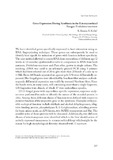Mostrar el registro sencillo del ítem
Gene expression during symbiosis in the ectomycorrhizal fungus Tricholoma vaccinum
| dc.creator | Krause, K. | es_ES |
| dc.creator | Kothe, E. | es_ES |
| dc.date.accessioned | 2018-02-14T09:31:33Z | |
| dc.date.available | 2018-02-14T09:31:33Z | |
| dc.date.issued | 2006 | |
| dc.identifier.isbn | 84-9769-107-5 | |
| dc.identifier.uri | https://hdl.handle.net/2454/27230 | |
| dc.description | Resumen de la conferencia presentada al VI Meeting on Genetics and Cellular Biology of Basidiomycetes (GCBB-VI), organizado por y celebrado en la Universidad Pública de Navarra el 3-6 de junio de 2005. | es_ES |
| dc.description.abstract | We have identified genes specifically expressed in host interaction using an RNA fingerprinting technique. These genes can subsequently be used to identify host signals for induction of genes with function in host specificity. The easy method allowed to screen RNA from mycorrhiza of different age (2 weeks to 13 months) synthesized in vitro in comparison to RNA from both partners, Tricholoma vaccinum and Picea abies, grown in single culture. The resulting cDNA was used in an arbitrarily primed PCR using 5 primers which had been selected out of 20 to give more than 20 bands of a size up to 1.9 kb. From 145 bands separated on agarose gels 52% were differentially expressed. The fungal genes were identified by Southern blot analyses and subsequenly differential expression was verifie by reversed Northern blots. Since the bands were, in many cases, still containing more than a single fragment, 130 fragmetns were cloned, of which 57 were mykorrhiza-specific. Of 23 fungal genes with mycorrhiza-specific expression, sequence analyses were performed in order to identify the nature of the encoded protein in silico. Among them different classes of function were defined with respect to putative function of the respective gene in the symbiosis. Examples with possible ecological function include aldehyde and alcohol dehydrogenases, ubiquitin binding protein, phospholipase B, ß-1,4 glucosidase, a binding protein for basic amino acids, an APS kinase, two MATE transporters and Ras. The possible roles of these proteins will be discussed. Additionally, two different classes of retrotransposon were identified which is the first identificaiton of actively expressed trnasposons in ectomycorrhizal fungi which might be the reason for high morphological diversity observed with T. vaccinum. | en |
| dc.format.extent | 1 p. | |
| dc.format.mimetype | application/pdf | en |
| dc.language.iso | eng | en |
| dc.publisher | Universidad Pública de Navarra / Nafarroako Unibertsitate Publikoa | es |
| dc.relation.ispartof | Antonio G. Pisabarro and Lucía Ramírez (eds.): VI Meeting on Genetics and Cellular Biology of Basidiomycetes (GCBB-VI). Pamplona: Universidad Pública de Navarra / Nafarroako Unibertsitate Publikoa, 2006. | es |
| dc.rights | © Autores; Universidad Pública de Navarra. Esta publicación no puede ser reproducida, almacenada o transmitida total o parcialmente, sea cual fuere el medio y el procedimiento, incluidas las fotocopias, sin permiso previo concedido por escrito por los titulares del copyright. | es_ES |
| dc.subject | Tricholoma vaccinum | en |
| dc.title | Gene expression during symbiosis in the ectomycorrhizal fungus Tricholoma vaccinum | en |
| dc.type | info:eu-repo/semantics/conferenceObject | en |
| dc.type | Contribución a congreso / Biltzarrerako ekarpena | es |
| dc.rights.accessRights | info:eu-repo/semantics/openAccess | en |
| dc.rights.accessRights | Acceso abierto / Sarbide irekia | es |
| dc.type.version | info:eu-repo/semantics/publishedVersion | en |
| dc.type.version | Versión publicada / Argitaratu den bertsioa | es |


